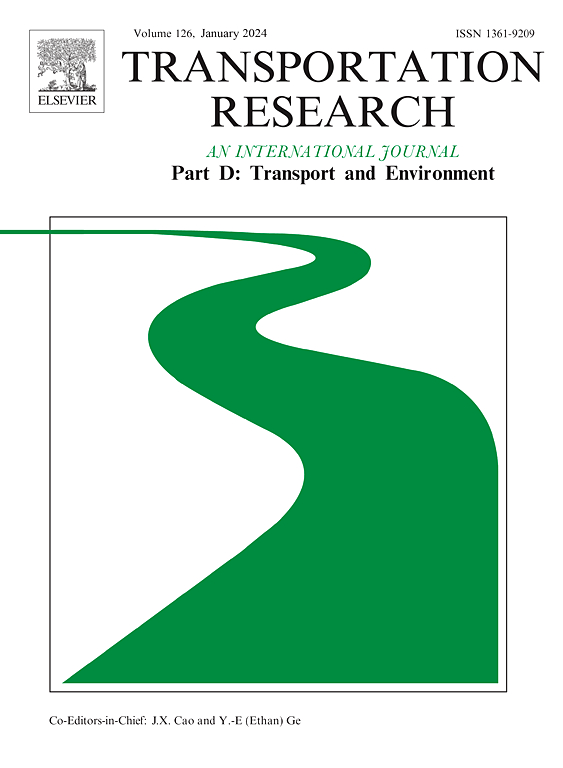城市共享拼车系统将出行距离缩短了50%以上
IF 7.7
1区 工程技术
Q1 ENVIRONMENTAL STUDIES
Transportation Research Part D-transport and Environment
Pub Date : 2025-04-26
DOI:10.1016/j.trd.2025.104726
引用次数: 0
摘要
合乘出行有可能减少必要的私家车数量和总行驶距离。在此,我们使用柏林的汽车出行记录作为合乘模拟的输入,以分析其技术潜力--假设完全从私人交通转向合乘交通。与个人驾驶相比,我们测量了可共享出行的比例、平均车辆占用率、相对乘客出行时间和相对驾驶距离。我们发现,在整个柏林地区,一个拥有 2.65 万辆汽车的合乘系统可以取代全部 109 万辆私家车及其出行。出行时间增加 55%,平均车辆占用率增加 2.1 倍,总行驶距离减少 61%。我们的研究结果表明,全系统的城市效率和生活质量效益--消除拥堵和为人们增加公共空间--将以通勤者更高的时间成本为代价。本文章由计算机程序翻译,如有差异,请以英文原文为准。
An urban shared pooled mobility system cuts distance travelled by over 50%
Shared pooled mobility has the potential to reduce both the necessary number of private vehicles and the total driven distance. Here, we use logged car trips in Berlin as input for ride-pooling simulations to analyze the technical potential − assuming a complete switch from private to shared mobility. We measure the share of sharable trips, average vehicle occupancy, relative passenger travel time, and relative driven distance compared to individual driving. In the entire area of Berlin, we observe that a ride-pooling system with 26,500 vehicles could replace all 1,09 million private vehicles and their trips. The travel time is 55% higher, the average vehicle occupancy increases 2.1-fold, and the overall distance traveled is reduced by 61%. Our results demonstrate that system-wide urban efficiency and quality of life benefits − elimination of congestion and gain of public space for people − would come at higher time costs for commuters.
求助全文
通过发布文献求助,成功后即可免费获取论文全文。
去求助
来源期刊
CiteScore
14.40
自引率
9.20%
发文量
314
审稿时长
39 days
期刊介绍:
Transportation Research Part D: Transport and Environment focuses on original research exploring the environmental impacts of transportation, policy responses to these impacts, and their implications for transportation system design, planning, and management. The journal comprehensively covers the interaction between transportation and the environment, ranging from local effects on specific geographical areas to global implications such as natural resource depletion and atmospheric pollution.
We welcome research papers across all transportation modes, including maritime, air, and land transportation, assessing their environmental impacts broadly. Papers addressing both mobile aspects and transportation infrastructure are considered. The journal prioritizes empirical findings and policy responses of regulatory, planning, technical, or fiscal nature. Articles are policy-driven, accessible, and applicable to readers from diverse disciplines, emphasizing relevance and practicality. We encourage interdisciplinary submissions and welcome contributions from economically developing and advanced countries alike, reflecting our international orientation.

 求助内容:
求助内容: 应助结果提醒方式:
应助结果提醒方式:


